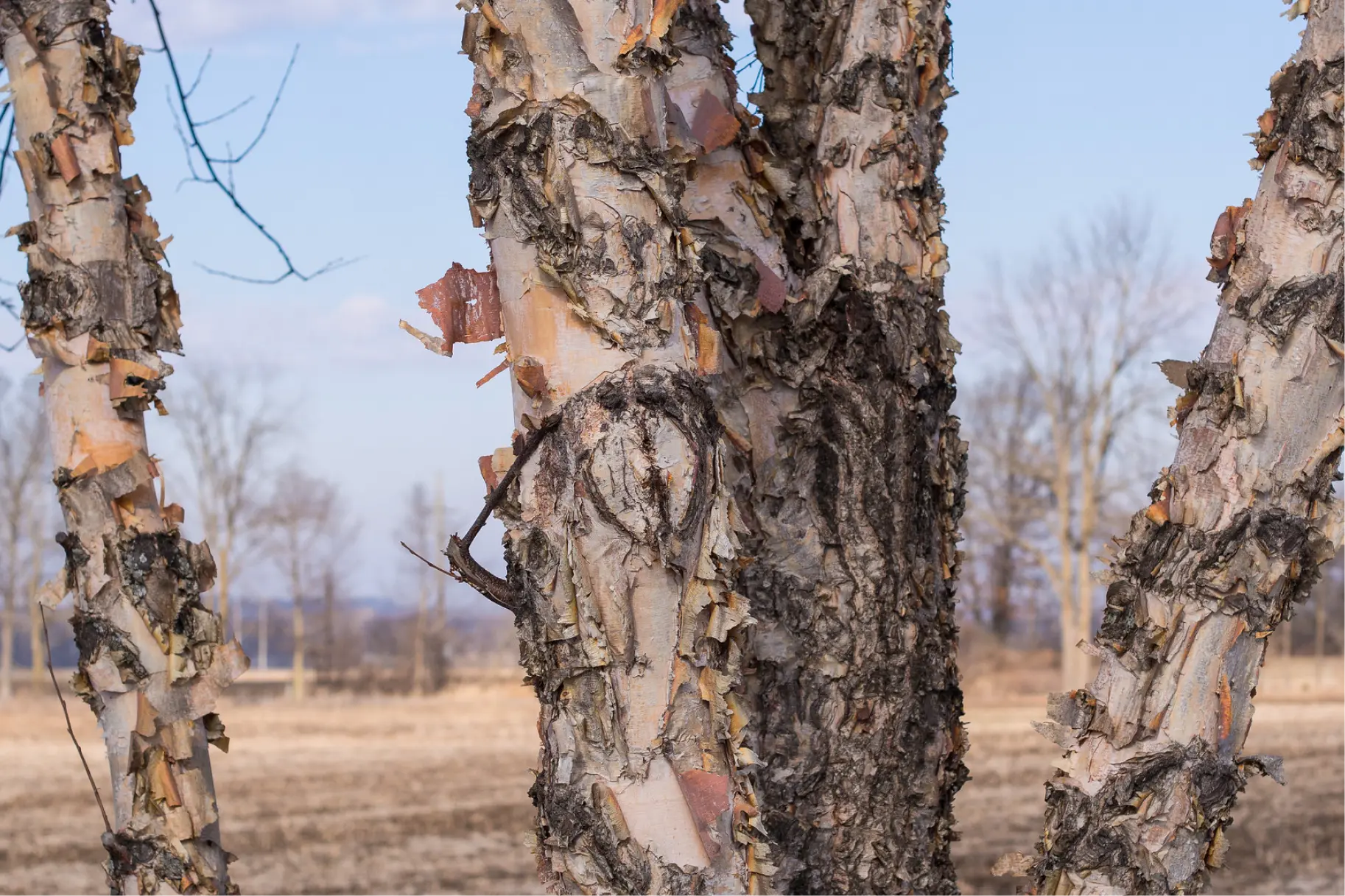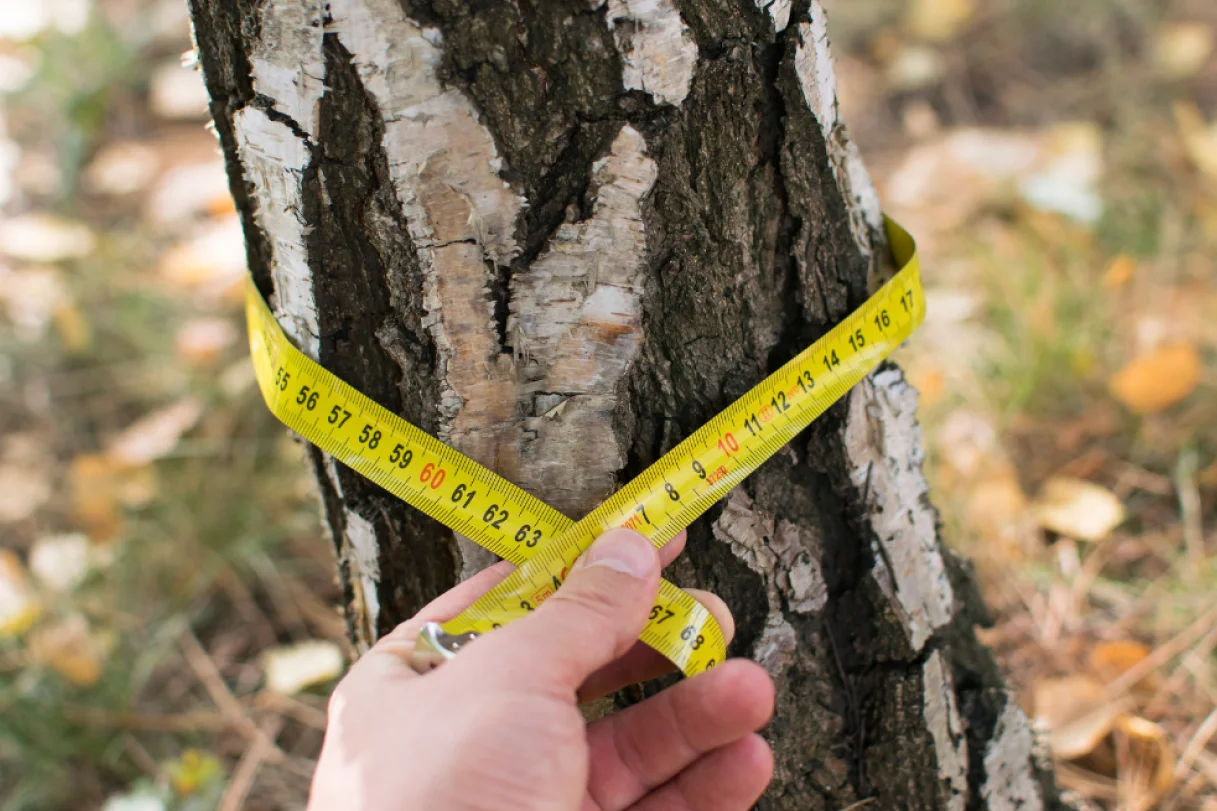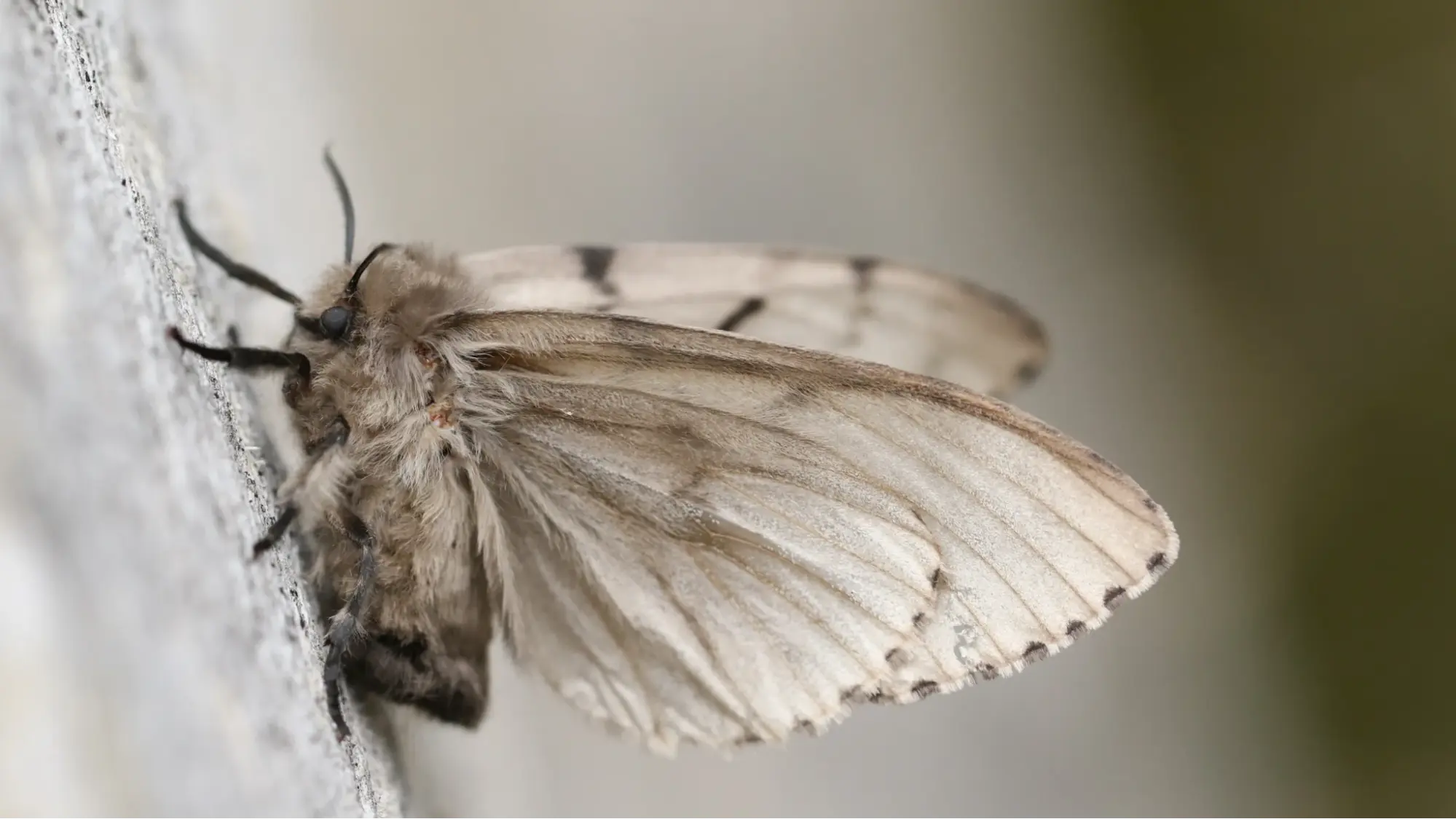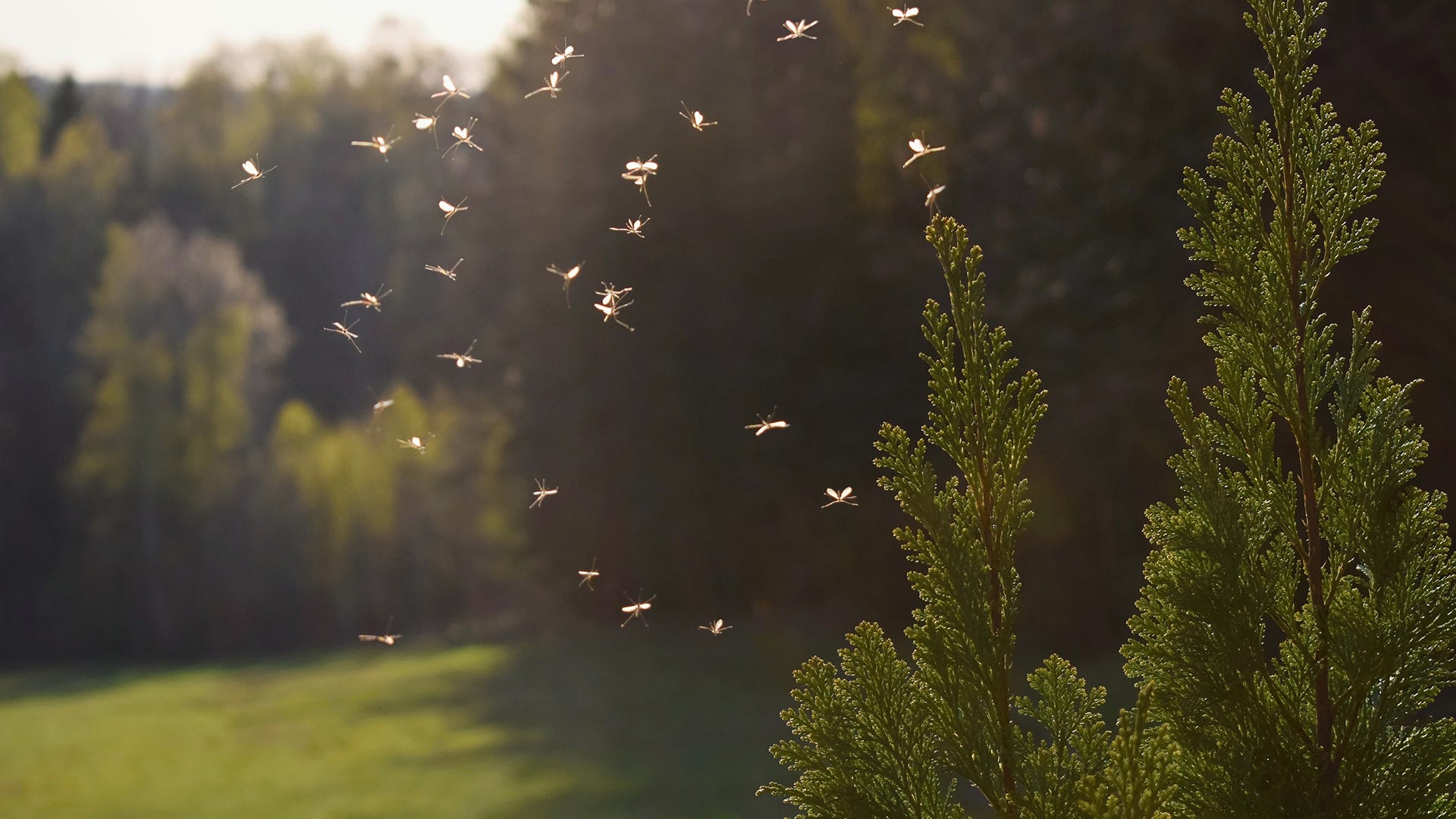River birch trees are a popular choice for landscaping, especially in moist or wet areas. Known for their peeling bark and elegant multi-trunked form, they add beauty and structure to any space. Small birch trees work well as accents, while mature river birches can grow 40–70 feet tall.
To thrive, plant them in full sun or partial shade with well-drained, moist soil. Early spring or autumn is ideal for planting so roots can establish before extreme weather.
When learning how to care for river birch trees, ensure consistent watering during the first few years, mulch to retain moisture, and apply a slow-release fertilizer in early spring. Light pruning in late winter to remove deadwood helps prevent disease and maintains a healthy shape.
What Are River Birch Trees?
The river birch tree (Betula nigra) is an adaptable and attractive addition to any landscape, offering both aesthetic appeal and practical benefits. Native to much of eastern North America, it naturally grows along rivers and wetlands, often reaching up to 80 feet tall. Its peeling bark, which ranges from salmon pink to cinnamon brown, makes the tree stand out even in winter when it has no leaves.
Visual Appeal and Practical Benefits
Beyond its striking appearance, the river birch is highly resistant to diseases and pests, making it a low-maintenance option for homeowners. Its ability to thrive in wet conditions makes it suitable for areas prone to flooding or poor drainage, helping to protect surrounding structures from waterlogging issues.
Considerations for Planting in Front Yards
When incorporating a river birch into a front yard landscape, consider its size and growth habit. These trees can become very large, so provide adequate space to prevent interference with buildings or nearby plants.
Root System and Growth Planning
River birches have shallow, wide-spreading roots, typical of the Betula genus. Proper placement is essential to avoid competition for nutrients and moisture with other plants. During drought periods, careful watering and planning ensure that the tree grows strongly without stunting nearby vegetation.
How to Care for River Birch Trees?
Taking care of river birch trees involves several key practices to ensure their health and longevity. Understanding the tree’s specific needs is the first step. River birches thrive in areas with high rainfall and naturally moist soils, though they can adapt to different conditions if properly maintained.

Regular watering, especially during dry periods, and mulching around the base of the tree help retain soil moisture and protect the roots. Pruning dead or damaged branches improves airflow and reduces the risk of disease, while monitoring for pests like aphids or borers ensures the tree stays healthy. With consistent care, river birch trees can grow strong, maintain their attractive peeling bark, and provide shade and beauty for many years.
Essential Care Practices
-
Watering: Keep soil consistently moist, especially during the first few years. During dry spells, water more frequently to support rapid growth.
-
Mulching: Apply mulch around the base to retain soil moisture, regulate temperature, and protect the shallow root system.
-
Fertilizing: Use a slow-release, balanced fertilizer once a year in early spring. Avoid high-nitrogen fertilizers that encourage excessive leaf growth at the expense of overall health.
-
Pruning: Remove only dead, damaged, or diseased branches. Prune in late winter or early spring before new growth begins to allow faster healing and reduce infection risk.
By following these steps, your river birch tree will remain healthy, vibrant, and a standout feature in your landscape for many years.
What Are Types of River Birch Trees?
When selecting a front yard river birch tree, it is important to know that there are different kinds of them. These varieties have distinct features, although they possess common characteristics.
One of the popular types of birch trees is known as ‘Heritage’ which has an excellent bark and strong growth habit. Many people choose river birch plant because it can resist diseases and grow well in various soil conditions. Another noteworthy variety is called ‘Dura-Heat’, which can tolerate heat better than other types hence suitable for hot areas like Southern states.
For those who want to plant a river birch but have limited space, they may consider growing ‘Little King’ or ‘Fox Valley’. These cultivars are compact and only reach about 10-20 feet tall, making them ideal for small yards or urban settings with restricted room. Another widely grown variety is named ‘Cully’ (also known as ‘Heritage’) due to its exfoliating bark and sturdy structure.
How to Grow River Birch Trees from Seed?
Growing a river birch tree from seed can be an enjoyable process although it may take some time and close attention to details. Begin by collecting seeds from a mature river birch around late summer or early autumn when they fall off naturally. The seeds are tiny, lightweight so you can pick them up easily either from under the tree or directly out of seedpods hanging on branches.
Once you have obtained your seeds, prepare a seed tray or pots filled with well-drained soil mixtures. Since light plays an important role in germination of such kind of seeds; therefore, just press them gently onto surface without burying too deep into compost. Lightly water soil to keep it moist but not soggy which might cause rotting.
So, how to grow birch trees? Put tray at place receiving indirect sunlight where temperature remains steady around 60-70°F (about 15-21°C). Usually, within two to three weeks they should start sprouting into tiny seedlings. As soon as you notice this happening, provide more moisture while gradually accustoming them to brighter light.
Can You Grow Birch Trees from Cuttings?
Yes, it is possible to grow birch trees from cuttings, though it requires patience and careful attention. This method is most successful with softwood or semi-hardwood cuttings taken in late spring or early summer, when the tree is actively growing.
But how to grow birch trees from cuttings? To start, select healthy branches free of disease or damage and cut sections about 6–8 inches long. Remove the lower leaves, leaving only a few at the top, and dip the cut ends in rooting hormone to encourage root development. Plant the cuttings in a well-draining mix of sand and peat or perlite, and keep the soil consistently moist but not waterlogged.
Place the cuttings in bright, indirect light and cover with a plastic bag or dome to maintain humidity. Roots typically form over several weeks, depending on the species and environmental conditions. Once the cuttings have developed a strong root system, they can be transplanted into larger pots or directly into the ground.
Growing birch trees from cuttings allows you to propagate your favorite varieties and can be a rewarding way to expand your landscape with new, genetically identical trees.
Can You Grow Birch Trees in Pots?
Yes, birch trees can be successfully grown in pots, making them a versatile option for patios, balconies, or small gardens. Small birch trees or young saplings are best suited for container growth, as mature trees can become quite large and may outgrow a pot over time.
When planting birches in containers, choose a large, sturdy pot with good drainage holes to prevent waterlogging. Use a well-draining potting mix, ideally a blend of peat, compost, and perlite, to support healthy root growth. Place the pot in a location that receives full sun to partial shade, depending on the birch species, to ensure vibrant foliage and strong growth.
Watering is crucial for potted birch trees because the soil dries out faster than ground soil. Keep the soil consistently moist, especially during hot or dry periods, but avoid letting it become soggy. Fertilize lightly once or twice a year with a balanced, slow-release fertilizer to provide essential nutrients.
With proper care — including occasional pruning and repotting every 2–3 years to refresh the soil and accommodate root growth — birch trees in pots can thrive and provide a striking, ornamental feature in your outdoor space.
How Long Do Birch Trees Live?
Birch trees are known for their beauty and graceful form, but they generally have a shorter lifespan compared to many other tree species. Most birches, including river birch trees and other common varieties, live between 40 and 50 years, although proper care and favorable growing conditions can sometimes extend this to 60 years or more.
Their lifespan is influenced by factors such as species type, soil quality, climate, and pest or disease pressure. River birches tend to be more resilient, especially in wet soils, while some ornamental birches may have shorter life expectancies due to environmental stress or shallow root systems.
Here’s a quick overview of birch tree lifespans by type:
| Birch Type | Average Lifespan | Notes |
|---|---|---|
| River Birch (Betula nigra) | 40–50 years | Tolerates wet soils; more disease-resistant |
| Paper Birch (Betula papyrifera) | 30–50 years | Sensitive to heat and drought; prefers cooler climates |
| Yellow Birch (Betula alleghaniensis) | 40–60 years | Slow-growing; prefers well-drained soils |
| Small Ornamental Birches | 20–40 years | Ideal for pots or small gardens; shorter lifespan due to limited root space |
Understanding the expected lifespan of your birch tree helps with planning for landscaping, maintenance, and long-term care. Proper watering, mulching, fertilization, and pruning can all contribute to maximizing the healthy years of these elegant trees.
River birch trees add both beauty and function to any landscape. To ensure they thrive, trust professional tree services Toronto to provide expert care, from planting to pruning and everything in between.
FAQ
What are river birch trees?
River birch trees (Betula nigra) are fast-growing, deciduous trees native to eastern North America. They are known for their peeling bark, multi-trunked form, and ability to thrive in moist or wet soils.
How to care for birch trees?
To care for river birch trees, provide consistent watering during the first few years, apply mulch to retain soil moisture, use a slow-release fertilizer in early spring, and prune lightly in late winter to remove dead or diseased branches.
Can you grow birch trees from seed?
Yes. Collect seeds in late summer or autumn, press them lightly onto well-draining soil, keep the soil moist, and provide indirect sunlight. Seedlings usually appear within 2–3 weeks, after which they can be gradually exposed to brighter light.
Can you grow birch trees from cuttings?
Yes, using softwood or semi-hardwood cuttings in late spring or early summer. Cut healthy branches, dip in rooting hormone, plant in well-draining soil, maintain moisture and humidity, and transplant once roots are established.
Can birch trees grow in pots?
Yes. Small birch trees or young saplings do well in large, well-draining containers. Ensure consistent watering, fertilize lightly, provide full sun to partial shade, and repot every 2–3 years.
How long do birch trees live?
Most birch trees live 40–50 years, although proper care can extend some varieties to 60 years or more. Small ornamental birches in pots may have shorter lifespans, around 20–40 years.
What are the types of river birch trees?
Popular varieties include "Heritage" (strong growth, exfoliating bark), "Dura-Heat" (heat-tolerant), "Little King" and "Fox Valley" (compact, ideal for small yards), and "Cully" (sturdy structure, attractive bark).
Where should I plant river birch trees?
Plant in full sun or partial shade with well-drained, moist soil. Provide enough space for their canopy and shallow root system to grow without interfering with buildings or other plants.
Are river birch trees pest-resistant?
Yes, they are more resistant to common birch diseases and pests, making them a low-maintenance choice for homeowners. Their peeling bark and strong growth habit also help deter many insects. However, regular monitoring is still important to catch any early signs of stress or infestation.
Can river birch trees handle wet conditions?
Absolutely. They are well-suited for areas prone to flooding or poor drainage, helping protect surrounding structures from waterlogging. In fact, river birches often thrive along riverbanks and wetlands, where their roots help stabilize the soil and prevent erosion.











